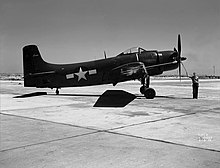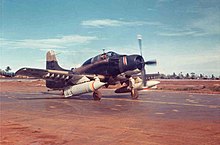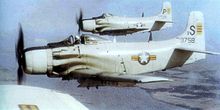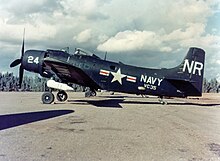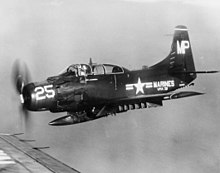Douglas A-1
| Douglas AD / A-1 Skyraider | |
|---|---|
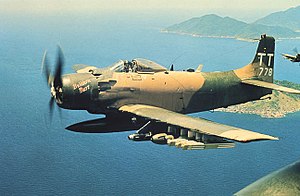 A-1H "Skyraider" of the US Air Force , 1970 |
|
| Type: | Ground attack aircraft |
| Design country: | |
| Manufacturer: | |
| First flight: |
March 11, 1945 |
| Commissioning: |
1946 |
| Production time: |
1945 to 1957 |
| Number of pieces: |
3180 |
The Douglas A-1 Skyraider (until 1962 Douglas AD Skyraider ) was a fighter-bomber from the US company Douglas Aircraft Company , which entered service in 1946.
development
As early as June 1941, the US Navy commissioned Douglas to develop a successor to the Douglas SBD Dauntless dive bomber , especially since the actual successor, the Curtiss SB2C Helldiver , had to deal with countless problems. Douglas then developed the two-seat Douglas SB2D Destroyer , which first flew on April 8, 1943. However, as a result of the war experience, the requirements for a carrier-based combat aircraft had changed so that only 28 SB2D were built. The US Navy now demanded an aircraft with the designation "BT", a single-seat fighter aircraft that should be used as a dive bomber ("B") and torpedo bomber ("T"). All drop weapons should be carried at outstations. Three aircraft manufacturers developed such an aircraft in 1943, Curtiss the BTC , Martin the BTM and Kaiser-Fleetwings the BTK . Douglas then converted the SB2D into a single-seat aircraft, which the US Navy refused in June 1944. Douglas' chief designer, Ed Heinemann , traveled to Washington DC that same month to change the mind of the US Navy. However, the Admiral in charge, Laurence B. Richardson, gave Heinemann only one night to submit a new proposal. Following permission from Douglas by telephone, Heinemann and two other designers, Leo Devlin and Gene Root, constructed the “BT2D Dauntless II” in just one night in a suite at the Statler Hotel. The US Navy was still not convinced, but Douglas was able to build a dummy by August 1944 and thus achieve that the last 15 machines from the original SB2D / BTD order should be completed as "XBT2D". The first prototype flew on March 11, 1945. Although the US Navy still favored the Martin BTM, Douglas was able to get orders for 548 BT2Ds, which were reduced to 277 after the end of the Second World War . In February 1946 the name of the machine was changed to "Skyraider", two months later the name was changed to "AD". In the meantime it became clear that the machine now known as Martin AM Mauler could carry more weapons, but the Skyraider was lighter and much easier to fly. On November 5, 1946, the first series aircraft flew the AD-1, which was first put into service in December 1946 with the VA-19A squadron of Naval Air Station Alameda.
A total of 3180 Skyraiders were built in seven basic versions. The AD-1 to AD-4, AD-6 and AD-7 were single-seat fighter aircraft. The AD-5 produced from 1951, however, had a widened and elongated fuselage that accommodated two pilots side by side. Theoretically, this version could be converted as an ambulance or transport aircraft for up to twelve people, but this was practically not used. The AD-1 to AD-5 had a large number of sub-versions that were equipped for night attacks ("N") or for electronic countermeasures ("Q"). The most obvious differences were the 418 early warning aircraft (“W”), which carried a large APS-20 radar under the fuselage. The "B" versions could carry nuclear weapons, which at the time were still part of the tactical arsenal of warfare. To use the additional designations of the Navy, see also the list of codes for special equipment . When the designation system for aircraft of the US armed forces was standardized in 1962 , the AD became the A-1 . Since the versions AD-1 to AD-3 were no longer flown, the designations A-1A to A-1C were not assigned. The versions still in service were given the new designations A-1D to A-1J.
The pilots called the Skyraider lovingly often Able Dog (after the name "AD") Spad (after the fighter Spad XIII of the AEF in World War I) and Sandy (after the radio call sign of the A-1 of the USAF during the Vietnam War).
commitment
In November 1946, the VA-19A squadron was the first to be equipped with the AD-1. By 1949 the Skyraider had then replaced the SB2C and TBM in the carrier squadrons . When the Korean War broke out on June 25, 1950 , Skyraiders of the VA-55 squadron flew the first attacks from the carrier Valley Forge after just five days . In this three-year conflict, US Navy Skyraiders flew 167,552 sorties and US Marine Corps 107,300 sorties. During these operations, the "Able Dogs" dropped around 120,000 tons of bombs. A total of 195 AD-2 / -3 / -4, seven AD-3W / -4W and nine AD-3Q / -4Q were lost.
After the Korean War, the Skyraiders were used wherever American aircraft carriers were in use, such as the Quemoy Crisis in 1955, the Lebanon Crisis in 1958 or the Cuban Missile Crisis in 1962 of the US Marine Corps the Skyraider flew. During the Vietnam War they were known as "Sandy's" for their role in close air support . From 1957 the Skyraider were then increasingly replaced by the Douglas A4D Skyhawk and from 1963 by the Grumman A-6 Intruder .
When the Vietnam War broke out in August 1964, the US Marine Corps had already retired the type, but almost every carrier squadron still had a squadron with A-1H / J. When the carrier squadrons of the aircraft carriers USS Ticonderoga and USS Constellation attacked North Vietnamese speedboat bases on August 5, after the so-called Tonkin incident, the Skyraider-equipped squadrons VA-52 and VA-145 were also involved. VA-145 lost the first machine and the first pilot during these missions. In total, the US Navy lost 65 A-1s. In Vietnam, A-1 of squadrons VA-25 of the USS Midway and VA-176 of the USS Intrepid could also shoot down several MiG-17s . The last combat mission flew on February 20, 1968, the A-1H BuNo. 135300 of Squadron VA-25 of Carrier Air Wing 15 of the carrier USS Coral Sea . After its retirement, the machine was handed over to the Museum of Naval Aviation in Pensacola (Florida). The EA-1F ended its career on December 21, 1969 when the VAQ-33 Squadron of Carrier Air Wing 1 completed its service on the USS John F. Kennedy . The last Skyraider in training and support squadrons were retired in 1972.
While the US Navy decommissioned the A-1, the Skyraider found increasing use in the United States Air Force during the Vietnam War . In the early 1960s, the USAF was looking for an aircraft with a high weapon load and long range for so-called Counter Insurgency (COIN) missions in " jungle wars ". The T-28D Trojan used by the USAF could not carry enough weapons and had too short a range. The Douglas B-26 Invader, which was also evaluated, was simply too old. The choice therefore fell on the A-1. In April 1963 the USAF took delivery of the first 150 A-1E. From February 1964, 25 of these were deployed to the 34th Tactical Group in South Vietnam. Four USAF squadrons flew the several hundred A-1E / G / H / J until November 1972 in Vietnam. The A-1 became best known for its SAR missions . Usually four A-1 escorts flew for HH-3E Jolly Green Giant - or HH-53C Super Jolly Green Giant helicopters trying to rescue downed aircraft crews. After the introduction of the portable anti-aircraft missile " Strela " (NATO code: SA-7 "Grail") around 1970, the losses of the A-1 in Vietnam increased dramatically, so that in 1972 all Skyraiders were handed over to the South Vietnamese Air Force. The USAF (1st Special Operations Squadron) skyraiders flew their last mission on November 7, 1972. In total, the USAF lost 195 skyraiders in the Vietnam War.
The Royal Navy of Great Britain used 50 AD-4Ws from 1951 to 1960, which were used by the 849 Naval Air Squadron from the British aircraft carriers as Skyraider AEW.1. A part of the squadron flew off board the HMS Bulwark (R08) also during the Suez crisis in 1956.
Twelve British AD-4Ws were handed over to Sweden as civil targeting aircraft in 1961 and, after the military equipment had been expanded, were used until the early 1970s.
In 1959/60 20 AD-4, 88 AD-4N and five AD-4NA were delivered to France , which were used until the end of the 1970s, mainly by the EEA20, 21 and 22 squadrons. Originally the Skyraiders were procured for use in the Algerian war . After the end of this conflict, the machines were used in Djibouti , Madagascar and Chad, among others . The last machine to fly was the AD-4N BuNo. 126965 on September 21, 1979 from Bordeaux .
France delivered 15 aircraft to Cambodia in 1965 , six to Chad (they were flown by mercenaries from 1974 to 1984) and eight to Gabon (these were also flown by French mercenaries).
The South Vietnamese Air Force (VNAF) also used A-1E / G / H / J. Between 1960 and 1972, the VNAF received approximately 289 A-1s that were flown by seven VNAF squadrons. The machines were in service until the end of the war in April 1975, and it is estimated that at least 217 Skyraiders were lost. Some were flown to Thailand, nothing is known about further missions in the service of North Vietnam.
Versions
A total of 3180 Skyraiders were built:
- AD-1
- 242 built, Wright-R-3350-24W engine with 2500 hp, two 20 mm guns
- AD-1Q
- 35 built, version for electronic warfare (ECM) with AN / APS-4 radar under the right wing and a second crew member behind the cockpit as a radar operator. He entered the aircraft through a separate door on the left side of the fuselage.
- XAD-1W
- Conversion of an AD-1 as a prototype of an early warning aircraft with APS-20 radar under the fuselage and a second crew member.
- AD-2
- Structurally reinforced version on the supporting structure that was equipped with additional tanks, a modified cockpit and 2700 hp R-3350-26W engine and thus enabled a higher weapon load. It was delivered from April 1948. 156 were built
- AD-2D
- Conversion of two AD-2 into drone guided aircraft
- AD-2Q
- 21 built, ECM version of the AD-2
- AD-2QU
- one built, targeting aircraft
- AD-3
- 124 built, reinforced structure, new cockpit, longer landing gear, improved propeller, improved cooling for the engine
- AD-3N
- 15 built between 1949 and 1950, night attack aircraft
- AD-3E
- Conversion of two AD-3Ns for submarine hunting
- AD-3S
- Conversion of two AD-3Ns for submarine search
- AD-3Q
- 23 built, ECM version
- AD-3W
- 31 built, three-seat and unarmed early warning aircraft with a large AN / APS-20 radar under the fuselage
- AD-4
- 373 built, with avionics improved by a P-1 autopilot and reinforced cockpit glazing, a more powerful engine and a modified catch hook were also installed. 28 converted to AD-4B
- AD-4B
- 165 built, device for dropping tactical atomic bombs, four 20 mm cannons
- AD-4L
- Conversion of 63 AD-4s with special winter equipment
- AD-4N
- 307 built, three-seat night attack aircraft
- AD-4NA
- 23 built and 77 AD-4N with extended night flight facilities; from 1962 A-1D, however these were already retired
- AD-4NL
- 37 AD-4N with winter equipment
- AD-4Q
- 39 built, ECM version
- AD-4W
- Built 168 early warning aircraft with AN / APS-20 radar, 50 were issued from 1954 to 1961 in the UK and there as Skyraider AEW.1 referred
- AD-5 (from 1962 A-1E)
- 212 built, widened version with two pilots side by side, large cockpit for up to four additional rear-facing seats as standard. Douglas developed a conversion kit that could accommodate up to twelve people in the rear cabin for COD operations. The fuselage was lengthened by 58 cm, the air brakes on the sides of the fuselage were removed and a larger tail fin was installed. The machine could also be converted into an ambulance aircraft (four beds), transporter or target display aircraft. The first flight of the AD-5 took place on August 17, 1951.
- AD-5N (from 1962 A-1G)
- 239 built, night attack aircraft
- AD-5Q (from 1962 EA-1F)
- 54 conversions from AD-5N, ECM version
- AD-5S
- a conversion from AD-5N, submarine fighter
- AD-5U (from 1962 UA-1E)
- AD-5 converted to target display aircraft
- AD-5W (from 1962 EA-1E)
- 218 built, early warning aircraft with a crew of three
- AD-6 (from 1962 A-1H)
- 713 built, single-seat fighter aircraft based on the AD-4B with a detachable canopy, reinforced armor in the cockpit area and target optics for precision attacks at low altitude.
- AD-7 (from 1962 A-1J)
- 72 built, structurally reinforced AD-6, 2088 kW R-3350-26W engine for operations at low altitude, first version delivered in gray / white. The last machine left production on February 18, 1957.
production
Acceptance of the Douglas Skyraider by the US Navy:
| version | 1946 | 1947 | 1948 | 1949 | 1950 | 1951 | 1952 | 1953 | 1954 | 1955 | 1956 | 1957 | TOTAL |
|---|---|---|---|---|---|---|---|---|---|---|---|---|---|
| AD-1 | 26th | 237 | 56 | 319 | |||||||||
| AD-2 | 155 | 1 | 156 | ||||||||||
| AD-2Q | 19th | 2 | 21st | ||||||||||
| AD-3 | 108 | 108 | |||||||||||
| AD-3N | 14th | 1 | 15th | ||||||||||
| AD-3Q | 22nd | 1 | 23 | ||||||||||
| AD-3W | 29 | 2 | 31 | ||||||||||
| AD-4 | 108 | 76 | 115 | 46 | 345 | ||||||||
| AD-4B | 2 | 58 | 133 | 193 | |||||||||
| AD-4N | 29 | 35 | 241 | 13 | 318 | ||||||||
| AD-4Q | 36 | 3 | 39 | ||||||||||
| AD-4W | 40 | 25th | 71 | 136 | |||||||||
| AD-4W MDAP | 4th | 9 | 8th | 21st | |||||||||
| AD-5 / A-1E | 39 | 172 | 211 | ||||||||||
| AD-5N / A-1G | 4th | 167 | 71 | 242 | |||||||||
| AD-5W / EA-1E | 27 | 169 | 21st | 217 | |||||||||
| AD-6 / A-1H | 115 | 248 | 206 | 144 | 713 | ||||||||
| AD-7 / A-1J | 58 | 14th | 72 | ||||||||||
| TOTAL | 26th | 237 | 230 | 284 | 185 | 184 | 425 | 312 | 614 | 446 | 223 | 14th | 3180 |
Between 1963 and 1972 the USAF took over a total of 414 A-1: 202 two-seat E (plus 15 conversions from EA-1E), 20 four-seat G, 155 H and 37 J. In addition there were 16 EA-1E and 14 EA-1F. In 1963: 9, 1964: 79, 1965: 64, 1966: 26, 1967: 96, 1968: 151, 1969: 9 aircraft, 1970: 9 aircraft and 1972: 1 aircraft. The USAF lost a total of 201 A-1s during the Vietnam War: 1964: 9, 1965: 30, 1966: 42, 1967: 16, 1968: 36, 1969: 29, 1970: 21, 1971: 10, 1972: 8 aircraft . The losses of the US Navy were significantly lower at 65 A-1 and 5 EA-1: 1964: 1, 1965: 25, 1966: 27, 1967: 11, 1968: 1. Losses EA-1: 1965: 2, 1966: 2, 1967: 1.
The number of Skyraiders taken over by the South Vietnamese Air Force can only be determined indirectly: on June 30, 1966 the number was 146 A-1 G, H and J. By this date, 88 A-1 had been lost, so that a total of 234 A- 1 were delivered at that time. Of these, 61 A-1 H came from the USAF, the rest came from the US Navy. The next deliveries were made in 1968, 1971 and 1972 with a total of 43 aircraft from the USAF. This means that 287 A-1s can be found in the service of the VNAF. By June 30, 1971, at least 192 A-1s had been lost.
Users
-
 France
France
-
 Gabon
Gabon
-
 Cambodia
Cambodia
-
 South Vietnam
South Vietnam
-
 Sweden
Sweden
-
 Thailand
Thailand
-
 Chad
Chad
-
 United States
United States
-
 United Kingdom
United Kingdom
- 40 Skyraider AEW.1 in the Royal Navy
-
 Vietnam
Vietnam
- several machines conquered after the defeat of South Vietnam
-
 Central African Republic
Central African Republic
Technical specifications
| Parameter | Data of the AD-7 / A-1J |
|---|---|
| Type | single-seat fighter-bomber |
| length | 11.84 m |
| span | 15.47 m |
| Wing area | 37.16 m² |
| Wing extension | 6.46 |
| Wing loading |
|
| height | 4.78 m |
| Empty mass | 4785 kg |
| Max. Takeoff mass | 11,340 kg |
| Top speed | 515 km / h |
| Service ceiling | 7740 m |
| Operational range | 1448 km |
| drive | a radial engine Wright R-3350-26B with 2800 PS (2088 kW) |
Armament
- four 20 mm guns
- up to 3629 kg external loads at 15 external load stations :
See also
literature
- Robert F. Dorr: Douglas A-1 Skyraider. Osprey Air Combat, Osprey Publishing, London 1989, ISBN 0-85045-906-0 .
- Gordon Swanborough, Peter M. Bowers : United States Navy Aircraft since 1911. Naval Institute Press, Annapolis (Maryland) 1990, ISBN 0-87021-792-5 .
Web links
- Skyraider Veterans Website
- Private Skyraider homepage
- Website of the National Museum of Naval Aviation with a link to the A-1
- Video clip - helmet camera in the Skyraider during formation with P-51 Mustang
Individual evidence
- ↑ FliegerRevue December 2011, pp. 52–55, Douglas A-1 Skyraider
- ↑ Statistical Digest of the USAF 1946, p. 94 ff; 1947, p. 115; 1948II, p. 16; 1949, p. 164 ff .; 1951, p. 153 ff .; 1952, p. 153 ff .; 1953, p. 185; 1954, p. 70; 1955, p. 80; 1956, p. 91; 1957, p. 97
- ↑ Statistical Digest of the USAF 1963 to 1969, table "USAF Aircraft Gains and Losses"
- ↑ Chris Hobson: Vietnam Air Losses. Hersham 2001, p. 268 f.
- ↑ USAF Statistical Digest 1961–1965: Table “Military Assistance Grant Aid Program Aircraft Attrition by Type”; USAF Statistical Digest 1961–1965: Table “MAP Supported Aircraft Inventory by Country, by Type”; USAF Statistical Digest 1966–1971: Table "Military Assistance (MASF and FWAF) Program Supported Aircraft"; USAF Statistical Digest 1972: Table "USAF Aircraft Gains and Losses"
